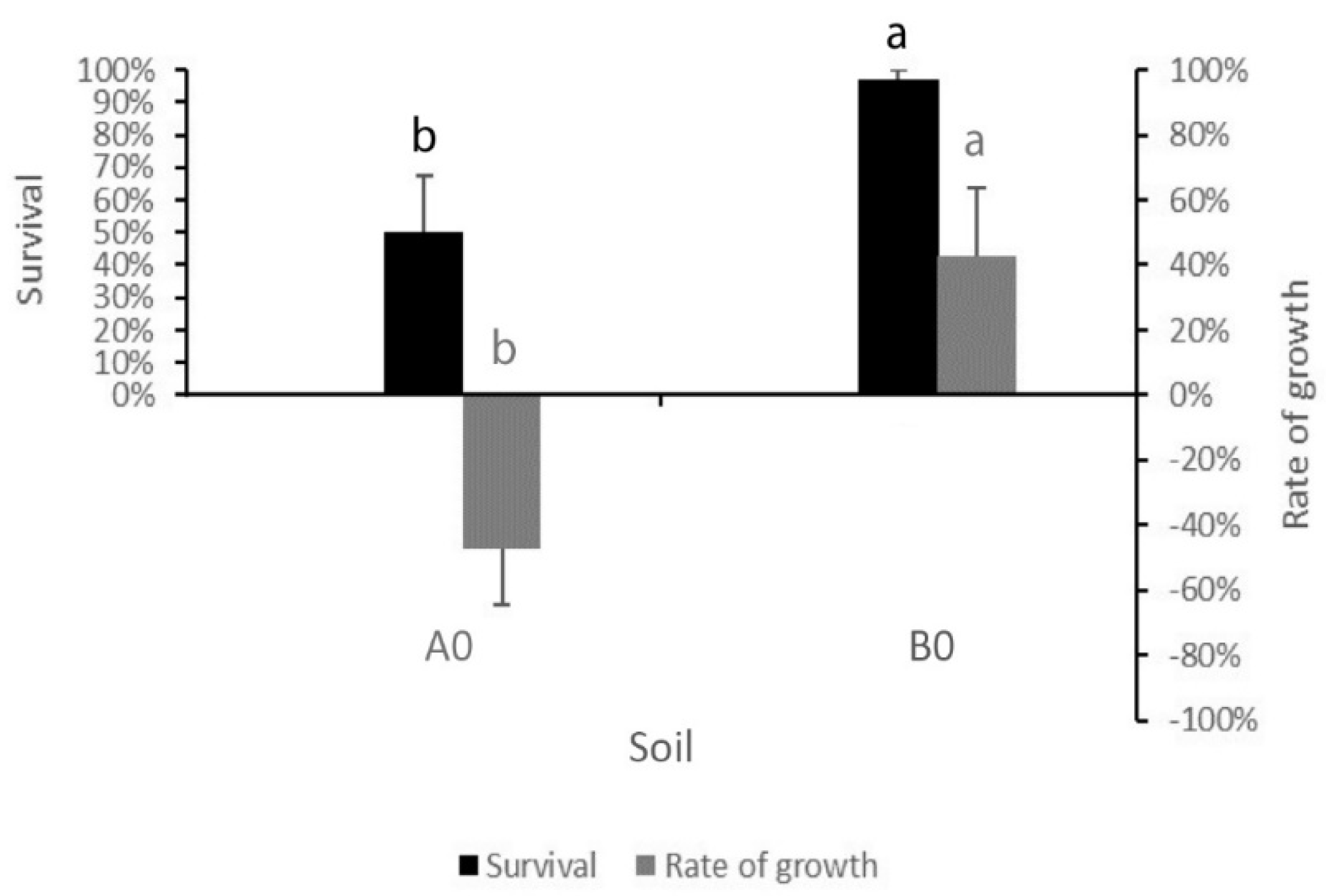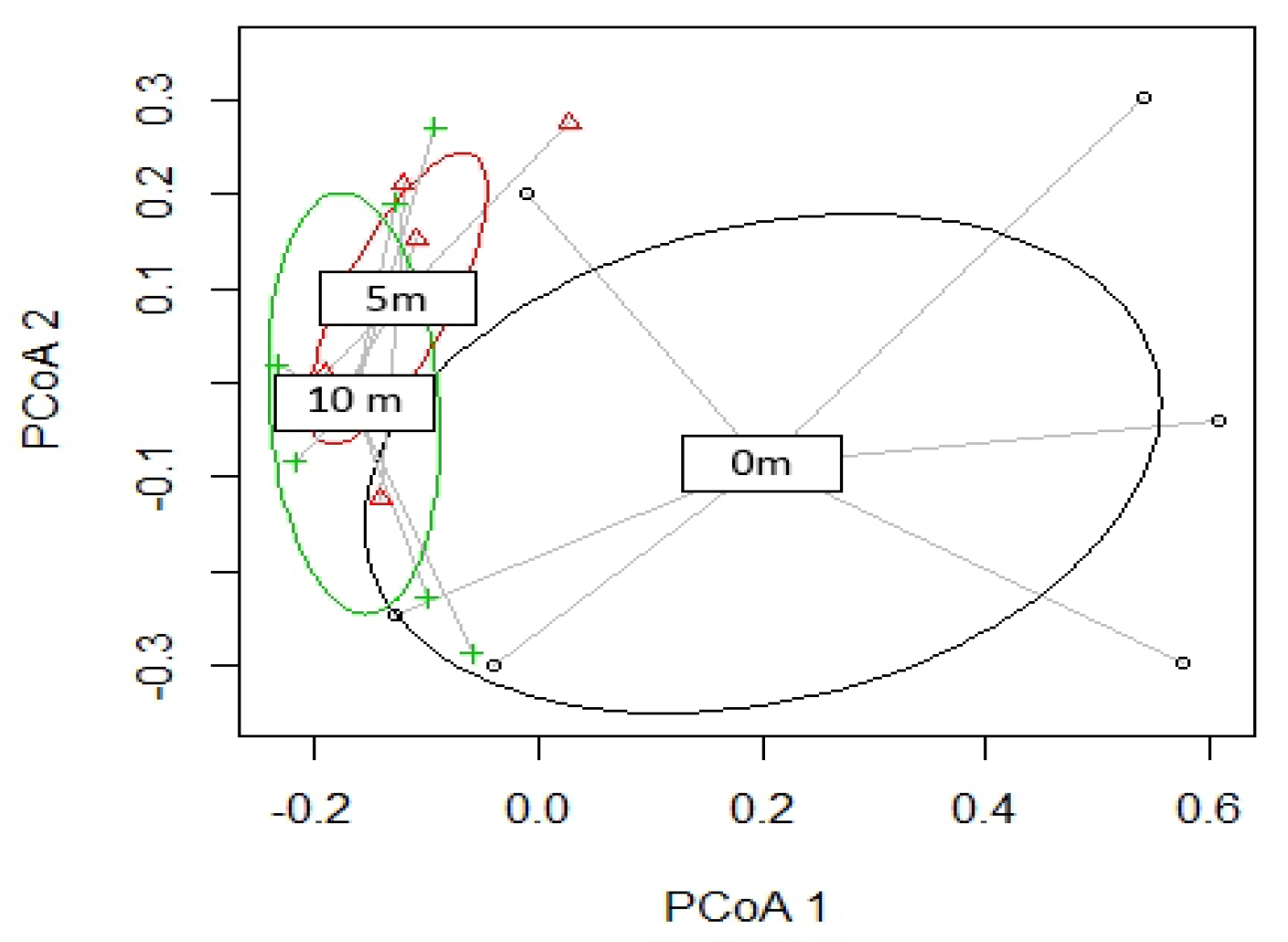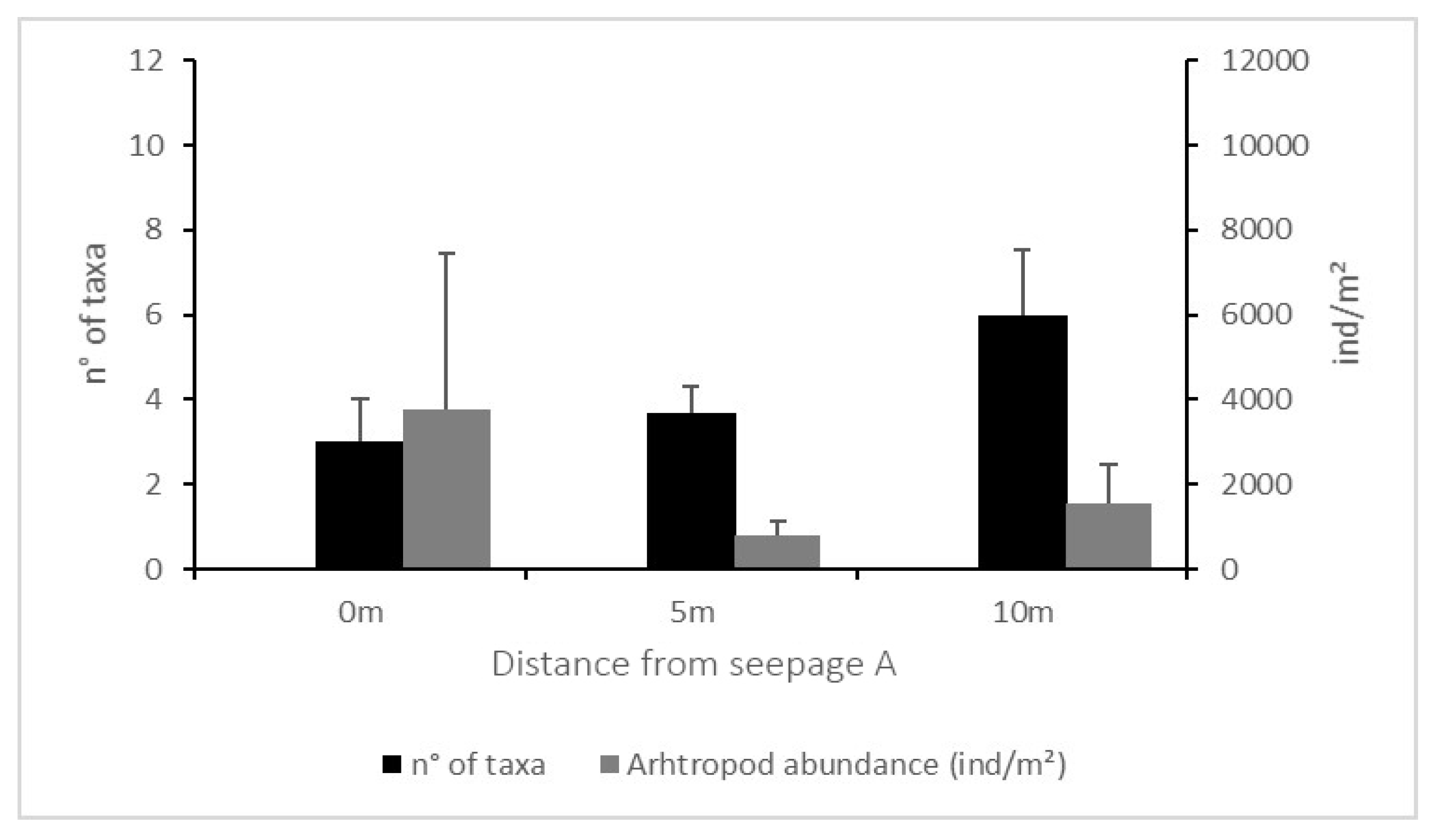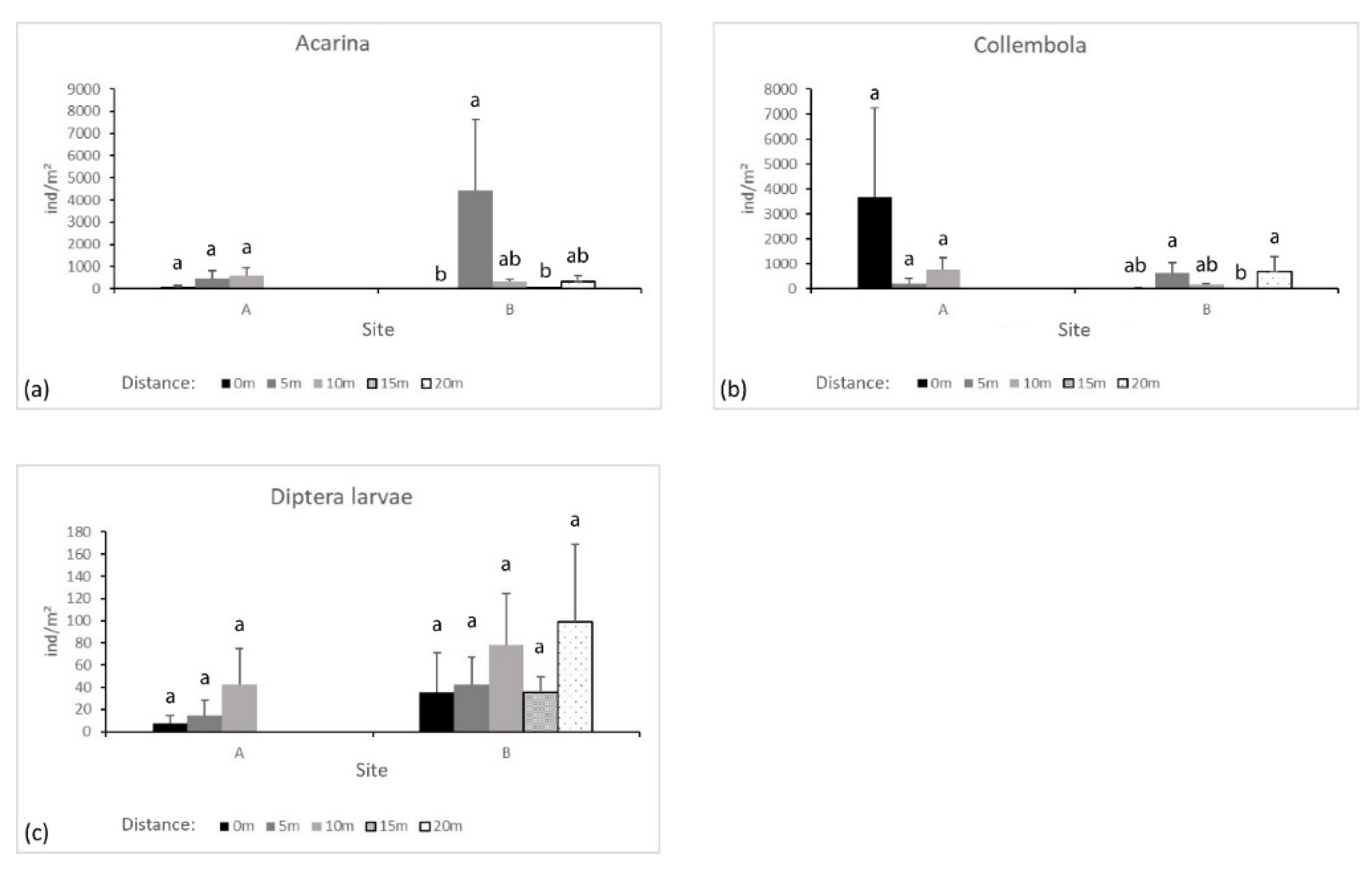Natural Surface Hydrocarbons and Soil Faunal Biodiversity: A Bioremediation Perspective
Abstract
:1. Introduction
2. Materials and Methods
2.1. Area of Study
2.2. Chemical Analysis on Soil
2.3. Ecotoxicological Tests on F. candida and E. fetida
2.4. Soil Fauna Extraction
2.5. Data Analysis
3. Results
3.1. Chemical Analysis on Soil
3.2. Ecotoxicological Tests on F. candida and E. fetida
3.3. Soil Fauna Characterization
3.3.1. Soil Microfauna
3.3.2. Soil Arthropods
4. Discussion
5. Conclusions
Author Contributions
Funding
Acknowledgments
Conflicts of Interest
References
- Nadim, F.; Hoag, G.E.; Liu, S.; Carley, R.J.; Zack, P. Detection and remediation of soil and aquifer systems contaminated with petroleum products: An overview. J. Pet. Sci. Eng. 2000, 26, 169–178. [Google Scholar] [CrossRef]
- Wang, Y.; Chen, H.; Chen, H.; Wu, J. Influences of chronic contamination of oil field exploitation on soil nematode communities at the Yellow River Delta of China. Front. Biol. China 2009, 4, 376–383. [Google Scholar] [CrossRef]
- Martinelli, G.; Cremonini, S.; Samonati, E. Geological and geochemical setting of natural hydrocarbon emissions in Italy. In Advances in Natural Gas Technology; Al-Megren, H., Ed.; IntechOpen: Rijeka, Croatia, 2012. [Google Scholar]
- Hoeks, J. Changes in composition of soil air near leaks in natural gas mains. Soil Sci. 1972, 113, 46–54. [Google Scholar] [CrossRef]
- Schumacher, D. Hydrocarbon-induced alteration of soils and sediments. AAPG Mem. 1996, 71–89. [Google Scholar] [CrossRef]
- Noomen, M.F.; Skidmore, A.K.; Van Der Meer, F.D. Detecting the influence of gas seepage on vegetation, using hyperspectral remote sensing. In Proceedings of the 3rd EARSeL Workshop on Imaging Spectroscopy, Herrsching, Germany, 13–16 May 2003; p. 256. [Google Scholar]
- Alvarez, P.J.J.; Vogel, T.M. Substrate interactions of benzene, toluene, and para-xylene during microbial degradation by pure cultures and mixed culture aquifer slurries. Appl. Environ. Microbiol. 1991, 57, 2981–2985. [Google Scholar] [CrossRef] [Green Version]
- Atlas, R.M. Microbial hydrocarbon degradation-bioremediation of oil spills. J. Chem. Technol. Biotechnol. 2007, 52, 149–156. [Google Scholar] [CrossRef]
- Erstfeld, K.M.; Snow-Ashbrook, J. Effects of chronic low-level PAH contamination on soil inverertebrate communities. Chemosphere 1999, 39, 2117–2139. [Google Scholar] [CrossRef]
- Iloba, B.N.; Odon, A.P. Studies on the biodiversity of soil microarthropods and their responses to crude oil spills. Int. J. Zool. Res. 2007, 3, 41–47. [Google Scholar] [CrossRef] [Green Version]
- Smith, R.; Pollard, S.J.T.; Weeks, J.M.; Nathanail, C.P. Assessing significant harm to terrestrial ecosystems from contaminated land. Soil Use Manag. 2006, 21, 527–540. [Google Scholar] [CrossRef] [Green Version]
- Migliorini, M.; Pigino, G.; Bianchi, N.; Bernini, F.; Leonzio, C. The effects of heavy metal contamination on the soil arthropod community of a shooting range. Environ. Pollut. 2004, 129, 331–340. [Google Scholar] [CrossRef] [PubMed]
- Faulkner, B.C.; Lochmiller, R.L. Increased abundance of terrestrial isopod populations in terrestrial ecosystems contaminated with petrochemical wastes. Arch. Environ. Contam. Toxicol. 2000, 39, 86–90. [Google Scholar] [CrossRef] [PubMed]
- Steichen, D.J.; Holbrook, S.J.; Osenberg, C.W. Distribution and abundance of benthic and demersal macrofauna within a natural hydrocarbon seep. Mar. Ecol. Prog. Ser. 1996, 138, 71–82. [Google Scholar] [CrossRef]
- Kaplan, D.L.; Hartenstein, R. Studies on monooxygenases and dioxygenases in soil macroinvertebrates and bacterial isolates from the gut of the terrestrial isopod, Oniscus asellus L. Comp. Biochem. Physiol. Part B Biochem. 1978, 60, 47–50. [Google Scholar] [CrossRef]
- Craig, J.; Gerali, F.; Macaulay, F.; Sorkhabi, R. The history of the European oil and gas industry (1600s–2000s). In Geological Society Special Publication; Geological Society of London: London, England, 2018; Volume 465, pp. 1–24. [Google Scholar]
- Van Dijk, J.P.; Affinito, V.; Atena, R.; Caputi, A.; Cestari, A.; D’Elia, S.; Giancipoli, N.; Lanzellotti, M.; Lazzari, M.; Oriolo, N.; et al. Cento Anni di Ricerca Petrolifera—L’Alta Val d’Agri (Basilicata, Italia meridionale). In Atti del 1º Congresso dell’Ordine dei Geologi di Basilicata,“Ricerca, Sviluppo ed Utilizzo delle Fonti Fossili: Il Ruolo del Geologo”; Dibuono Edizioni: Potenza, Italy, 2012. [Google Scholar]
- Merlini, S.; Mostardini, F. Appennino centro-meridionale: Sezioni geologiche e proposta di modello strutturale. Mem. Soc. Geol. Ital. 1986, 35, 177–202. [Google Scholar]
- Butler, R.W.H.; Corrado, S.; Mazzoli, S.; De Donatis, M.; Di Bucci, D.; Naso, G.; Scrocca, D.; Nicolai, C.; Zucconi, V. Time and space variability of «thin-skinned» and «thick-skinned» thrust tectonics in the Apennines (Italy)Variabilità spazio-temporale degli stili tettonici nella catena a pieghe e sovrascorrimenti appenninica. Rend. Lincei 2000, 11, 5–39. [Google Scholar] [CrossRef]
- Menardi Noguera, A.; Rea, G. Deep structure of the Campanian–Lucanian arc (southern Apennine, Italy). Tectonophysics 2000, 324, 239–265. [Google Scholar] [CrossRef]
- Wavrek, D.A.; Mosca, F. Compositional grading in the oil column: Advances from a mass balance and quantitative molecular analysis. Geol. Soc. Spec. Publ. 2004, 237, 207–220. [Google Scholar] [CrossRef]
- QGIS Development Team QGIS Geographic Information System. Open Source Geospatial Foundation Project; Map tiles by Stamen Design, under CC BY 3.0. Data by OpenStreetMap, under ODbL; QGIS Development Team QGIS Geographic Information System: Redlands, CA, USA, 2020. [Google Scholar]
- Regione Basilicata. DataBase GeoTopografico (DBGT) della Regione Basilicata. Available online: https://rsdi.regione.basilicata.it/dbgt-ctr/ (accessed on 25 June 2020).
- Olita, F. Investigation of the Natural Hydrocarbon Manifestations and 3D Reconstruction of the Reservoir in the Tramutola Area (Basilicata). Master’s Thesis, University of Basilicata, Potenza, Italy, 2019. [Google Scholar]
- Drogue, C. Hydrodynamics of karstic aquifers: Experimental sites in the Mediterranean karst, Southern France. In Hydrogeology of Selected Karst Regions; Back, W., Herman, J.S., Paloc, H., Eds.; International Association of Hydrogeologists: Heise, Hannover, 1992; pp. 133–149. ISBN 3-922705-94-4. [Google Scholar]
- Celico, F.; Petrella, E.; Celico, P. Hydrogeological behaviour of some fault zones in a carbonate aquifer of Southern Italy: An experimentally based model. Terra Nov. 2006, 18, 308–313. [Google Scholar] [CrossRef]
- Petrella, E.; Capuano, P.; Carcione, M.; Celico, F. A high-altitude temporary spring in a compartmentalized carbonate aquifer: The role of low-permeability faults and karst conduits. Hydrol. Process. 2009, 23, 3354–3364. [Google Scholar] [CrossRef]
- Bucci, A.; Petrella, E.; Naclerio, G.; Gambatese, S.; Celico, F. Bacterial migration through low-permeability fault zones in compartmentalised aquifer systems: A case study in Southern Italy. Int. J. Speleol. 2014, 43, 273–281. [Google Scholar] [CrossRef] [Green Version]
- Aquino, D.; Petrella, E.; Florio, M.; Celico, P.; Celico, F. Complex hydraulic interactions between compartmentalized carbonate aquifers and heterogeneous siliciclastic successions: A case study in southern Italy. Hydrol. Process. 2015, 29, 4252–4263. [Google Scholar] [CrossRef]
- Petrella, E.; Aquino, D.; Fiorillo, F.; Celico, F. The effect of low-permeability fault zones on groundwater flow in a compartmentalized system. Experimental evidence from a carbonate aquifer (Southern Italy). Hydrol. Process. 2015, 29, 1577–1587. [Google Scholar] [CrossRef]
- Agosta, F.; Alessandroni, M.; Antonellini, M.; Tondi, E.; Giorgioni, M. From fractures to flow: A field-based quantitative analysis of an outcropping carbonate reservoir. Tectonophysics 2010, 490, 197–213. [Google Scholar] [CrossRef]
- Ferraro, F.; Grieco, D.S.; Agosta, F.; Prosser, G. Space-time evolution of cataclasis in carbonate fault zones. J. Struct. Geol. 2018, 110, 45–64. [Google Scholar] [CrossRef]
- Giuffrida, A.; La Bruna, V.; Castelluccio, P.; Panza, E.; Rustichelli, A.; Tondi, E.; Giorgioni, M.; Agosta, F. Fracture simulation parameters of fractured reservoirs: Analogy with outcropping carbonates of the Inner Apulian Platform, southern Italy. J. Struct. Geol. 2019, 123, 18–41. [Google Scholar] [CrossRef]
- Hernàndez-Diaz, R.; Petrella, E.; Bucci, A.; Naclerio, G.; Feo, A.; Sferra, G.; Chelli, A.; Zanini, A.; Gonzalez-Hernandez, P.; Celico, F. Integrating hydrogeological and microbiological data and modelling to characterize the hydraulic features and behaviour of coastal carbonate aquifers: A case in western Cuba. Water 2019, 11, 1989. [Google Scholar] [CrossRef] [Green Version]
- Rizzo, P.; Bucci, A.; Sanangelantoni, A.M.; Iacumin, P.; Celico, F. Coupled microbiological-isotopic approach for studying hydrodynamics in deep reservoirs: The case of the Val d’Agri oilfiled (Southern Italy). Water 2020, 12, 1483. [Google Scholar] [CrossRef]
- De Vita, P.; Allocca, V.; Celico, F.; Fabbrocino, S.; Cesaria, M.; Monacelli, G.; Musilli, I.; Piscopo, V.; Scalise, A.R.; Summa, G.; et al. Hydrogeology of continental Southern Italy. J. Maps 2018, 14, 230–241. [Google Scholar]
- International Standard Organization (ISO). Soil Quality—Inhibition of Reproduction of Collembola (Folsomia Candida) by Soil Pollutants; ISO: Geneva, Switzerland, 1999; No. 11267. [Google Scholar]
- International Standard Organization (ISO). Soil Quality—Effects of Pollutants on Earthworms; ISO: Geneva, Switzerland, 1998; No. 11268. [Google Scholar]
- McDonald, J. Tests for one measurement variable. In Handbook of Biological Statistics; Publishing, S.H., Ed.; Sparky House Publishing: Baltimore, MD, USA, 2014; pp. 140–145. ISBN 9780444535924. [Google Scholar]
- Maxime, H. RVAideMemoire: Testing and Plotting Procedures for Biostatistics. Available online: https://CRAN.R-project.org/package=RVAideMemoire (accessed on 15 June 2020).
- Oksanen, J.; Blanchet, F.G.; Kindt, R.; Legendre, P.; O’Hara, R.B.; Simpson, G.L.; Solymos, P.; Stevens, M.H.H.; Wagner, H. Vegan: Community Ecology Package. Available online: https://CRAN.R-project.org/package=vegan (accessed on 15 June 2020).
- R Core Team. R: A Language and Environment for Statistical Computing; R Core Team: Vienna, Austria, 2020. [Google Scholar]
- Van Straalen, N.M.; Verhoef, H.A. The development of a bioindicator system for soil acidity based on arthropod pH preferences. J. Appl. Ecol. 1997, 34, 217. [Google Scholar] [CrossRef]
- García-Segura, D.; Castillo-Murrieta, I.M.; Martínez-Rabelo, F.; Gomez-Anaya, A.; Rodríguez-Campos, J.; Hernández-Castellanos, B.; Contreras-Ramos, S.M.; Barois, I. Macrofauna and mesofauna from soil contaminated by oil extraction. Geoderma 2018, 332, 180–189. [Google Scholar] [CrossRef]
- Schaefer, M.; Juliane, F. The influence of earthworms and organic additives on the biodegradation of oil contaminated soil. Appl. Soil Ecol. 2007, 36, 53–62. [Google Scholar] [CrossRef]
- Shakir Hanna, S.H.; Weaver, R.W. Earthworm survival in oil contaminated soil. Plant Soil 2002, 240, 127–132. [Google Scholar] [CrossRef]
- Schaefer, M.; Petersen, S.O.; Filser, J. Effects of Lumbricus terrestris, Allolobophora chlorotica and Eisenia fetida on microbial community dynamics in oil-contaminated soil. Soil Biol. Biochem. 2005, 37, 2065–2076. [Google Scholar] [CrossRef]
- Ceccanti, B.; Masciandaro, G.; Garcia, C.; MacCi, C.; Doni, S. Soil bioremediation: Combination of earthworms and compost for the ecological remediation of a hydrocarbon polluted soil. Water Air Soil Pollut. 2006, 177, 383–397. [Google Scholar] [CrossRef]
- Spies, R.B.; Davis, P.H. The infaunal benthos of a natural oil seep in the Santa Barbara channel. Mar. Biol. 1979, 50, 227–237. [Google Scholar] [CrossRef]
- Montagna, P.A.; Bauer, J.E.; Toal, J.; Hardin, D.; Spies, R.B. Temporal variability and the relationship between benthic meiofaunal and microbial populations of a natural coastal petroleum seep. J. Mar. Res. 1987, 45, 761–789. [Google Scholar] [CrossRef]
- Chan, H. Biodegradation of petroleum oil achieved by bacteria and nematodes in contaminated water. Sep. Purif. Technol. 2011, 80, 459–466. [Google Scholar] [CrossRef]
- Blakely, J.K.; Neher, D.A.; Spongberg, A.L. Soil invertebrate and microbial communities, and decomposition as indicators of polycyclic aromatic hydrocarbon contamination. Appl. Soil Ecol. 2002, 21, 71–88. [Google Scholar] [CrossRef]
- Montagna, P.; Bauer, J.; Prieto, M.; Hardin, D.; Spies, R. Benthic metabolism in a natural coastal petroleum seep. Mar. Ecol. Prog. Ser. 1986, 34, 31–40. [Google Scholar] [CrossRef]
- Beyrem, H.; Louati, H.; Essid, N.; Aïssa, P.; Mahmoudi, E. Effects of two lubricant oils on marine nematode assemblages in a laboratory microcosm experiment. Mar. Environ. Res. 2010, 69, 248–253. [Google Scholar] [CrossRef] [Green Version]
- Rizzo, P.; Malerba, M.; Bucci, A.; Sanangelantoni, A.M.; Remelli, S.; Celico, F. Potential enhancement of the in-situ bioremediation of contaminated sites through the isolation and screening of bacterial strains in natural hydrocarbon springs. Water 2020, 12, 2090. [Google Scholar] [CrossRef]
- Hopkin, S.P. Biology of the Springtails (Insecta, Collembola); Oxford University Press: New York, NY, USA, 1997; ISBN 9780198540847. [Google Scholar]
- Menta, C.; Remelli, S. Soil health and arthropods: From complex system to worthwhile investigation. Insects 2020, 11, 54. [Google Scholar] [CrossRef] [PubMed] [Green Version]
- Weber, G. Die Nematocera (Insecta: Diptera) eines klärschlammgedüngten und schwermetallbelasteten Ackers: Ökologie und Larvalbiologie; Universität Carolo-Wilhelmina zu Braunschweig: Braunschweig, Germany, 1993. [Google Scholar]
- Melekhina, E.N. Recovery successions of soil microfauna in oil-polluted ecosystems of the European subarctic. Biol. Bull. 2020, 47, 97–105. [Google Scholar] [CrossRef]
- Migliorini, M.; Petrioli, A.; Bernini, F. Comparative analysis of two edaphic zoocoenoses (Oribatid mites and Carabid beetles) in five habitats of the “Pietraporciana” and “Lucciolabella” Nature Reserves (Orcia Valley, central Italy). Acta Oecol. 2002, 23, 361–374. [Google Scholar] [CrossRef]







| Soil A0 (mg/kg) | Soil B0 (mg/kg) | |
|---|---|---|
| Dry weight content at 105 °C (%) | 63.5 | 43.3 |
| Skeleton between 2 cm and 2 mm (%) | 56.3 | 1.0 |
| Benzene | <0.01 | <0.01 |
| Etilbenzene | <0.05 | <0.05 |
| Styrene | <0.05 | <0.05 |
| Toluene | <0.05 | <0.05 |
| Xylenes | <0.05 | <0.05 |
| o-Xylene | <0.05 | <0.05 |
| p,m-Xilenes | <0.05 | <0.05 |
| Total aromatic compounds (D. Lgs.152/06) | <0.10 | <0.10 |
| Benzo(a)anthracene | 0.16 | 0.95 |
| Benzo(a)pyrene | <0.01 | <0.01 |
| Benzo(b)fluoranthene | <0.05 | 3.93 |
| Benzo(k)fluoranthene | <0.05 | 0.58 |
| Benzo(g,h,i)perylene | 0.28 | 1.45 |
| Chrysene | 0.21 | 1.23 |
| Dibenzo(a,e)pyrene | <0.01 | <0.01 |
| Dibenzo(a,l)pyrene | <0.01 | 0.10 |
| Dibenzo(a,i)pyrene | <0.01 | <0.01 |
| Dibenzo(a,h)pyrene | <0.01 | <0.01 |
| Dibenzo(a,h)anthracene | <0.01 | 0.34 |
| Indeno(1,2,3-c,d)pyrene | 0.05 | 0.19 |
| Pyrene | <0.05 | 0.61 |
| Total IPA (D.Lgs. 152/06 All.5 Table 1) | <1.0 | 8.25 |
| A | B | |||||||||||||||||||||||
|---|---|---|---|---|---|---|---|---|---|---|---|---|---|---|---|---|---|---|---|---|---|---|---|---|
| 0 m | 5 m | 10 m | 0 m | 5 m | 10 m | 15 m | 20 m | |||||||||||||||||
| Microfauna (<200 μm) | ||||||||||||||||||||||||
| Ciliophora | 7.33 | ± | 6.36 | 3.33 | ± | 3.33 | 8.67 | ± | 4.67 | - | 2.00 | ± | 1.15 | 1.33 | ± | 0.67 | - | 0.67 | ± | 0.67 | ||||
| Nematoda | 16.00 | ± | 13.11 | 36.67 | ± | 15.68 | 74.00 | ± | 22.72 | 9.33 | ± | 3.53 | 67.33 | ± | 40.16 | 38.00 | ± | 20.53 | 4.67 | ± | 2.91 | 18.00 | ± | 11.02 |
| Rotifera | - | 1.33 | ± | 1.33 | 5.33 | ± | 0.67 | - | - | - | - | - | ||||||||||||
| Sarcomastigophora | 0.67 | ± | 0.67 | 1.33 | ± | 1.33 | - | - | - | 0.67 | ± | 0.67 | - | 2.00 | ± | 1.15 | ||||||||
| Tardigrada | - | - | 0.67 | ± | 0.67 | - | 4.67 | ± | 2.91 | 2.67 | ± | 1.76 | - | 0.67 | ± | 0.67 | ||||||||
| Microarthropods (200 μm–2 mm) | ||||||||||||||||||||||||
| Acarina | 92.00 | ± | 81.61 | 481.21 | ± | 353.83 | 608.59 | ± | 314.97 | - | 4415.84 | ± | 3220.18 | 304.30 | ± | 128.75 | 7.08 | ± | 7.08 | 311.37 | ± | 290.14 | ||
| Araneidae | - | - | - | - | - | - | 7.08 | ± | 7.08 | - | ||||||||||||||
| Chilopoda | - | - | 56.61 | ± | 37.45 | - | - | - | - | - | ||||||||||||||
| Coleoptera | 7.08 | ± | 7.08 | 49.54 | ± | 25.52 | 35.38 | ± | 18.72 | - | 49.54 | ± | 18.72 | 14.15 | ± | 14.15 | 7.08 | ± | 7.08 | 28.31 | ± | 14.15 | ||
| larvae | - | 49.54 | ± | 25.52 | 21.23 | ± | 12.28 | - | 35.38 | ± | 14.15 | 7.08 | ± | 7.08 | - | 7.08 | ± | 7.08 | ||||||
| Collembola | 3651.56 | ± | 3588.06 | 226.45 | ± | 183.99 | 750.13 | ± | 504.98 | 28.31 | ± | 28.31 | 643.98 | ± | 396.10 | 169.84 | ± | 53.43 | - | 707.67 | ± | 580.80 | ||
| Diplura | - | - | - | - | 14.15 | ± | 14.15 | - | - | - | ||||||||||||||
| Diptera | 7.08 | ± | 7.08 | 14.15 | ± | 14.15 | 42.46 | ± | 32.43 | 42.46 | ± | 42.46 | 70.77 | ± | 30.85 | 84.92 | ± | 44.19 | 42.46 | ± | 12.26 | 183.99 | ± | 60.46 |
| larvae | 7.08 | ± | 7.08 | 14.15 | ± | 14.15 | 42.46 | ± | 32.43 | 35.38 | ± | 35.38 | 42.46 | ± | 24.51 | 77.84 | ± | 46.40 | 28.31 | ± | 28.31 | 162.76 | ± | 51.03 |
| Hemiptera | - | - | 7.08 | ± | 7.08 | 7.08 | ± | 7.08 | 42.46 | ± | 42.46 | 21.23 | ± | 21.23 | - | 92.00 | ± | 46.40 | ||||||
| Hymenoptera | 14.15 | ± | 14.15 | 7.08 | ± | 7.08 | 14.15 | ± | 14.15 | - | 42.46 | ± | 24.51 | 21.23 | ± | 0.00 | - | 70.77 | ± | 60.46 | ||||
| larvae | - | - | 14.15 | ± | 14.15 | - | - | - | - | - | ||||||||||||||
| Isopoda | 7.08 | ± | 7.08 | 14.15 | ± | 14.15 | 14.15 | ± | 7.08 | - | 35.38 | ± | 18.72 | - | - | 106.15 | ± | 76.55 | ||||||
| Lepidoptera | 7.08 | ± | 7.08 | - | - | - | - | - | - | - | ||||||||||||||
| larvae | 7.08 | ± | 7.08 | - | - | - | - | - | - | - | ||||||||||||||
| Pauropoda | - | - | - | - | 155.69 | ± | 123.99 | - | - | - | ||||||||||||||
| Pseudoscorpionida | - | - | - | - | 7.08 | ± | 7.08 | - | - | - | ||||||||||||||
| Psocoptera | - | - | 7.08 | ± | 7.08 | - | 7.08 | ± | 7.08 | 7.08 | ± | 7.08 | - | - | ||||||||||
| Symphyla | - | - | 28.31 | ± | 28.31 | - | 35.38 | ± | 35.38 | 7.08 | ± | 7.08 | - | - | ||||||||||
| 1-D | 0.19 | ± | 0.16 | 0.40 | ± | 0.11 | 0.64 | ± | 0.09 | 0.49 | ± | 0.29 | 0.44 | ± | 0.09 | 0.67 | ± | 0.07 | 0.35 | ± | 0.17 | 0.67 | ± | 0.05 |
| H | 0.38 | ± | 0.31 | 0.73 | ± | 0.14 | 1.25 | ± | 0.29 | 0.22 | ± | 0.22 | 0.95 | ± | 0.19 | 1.31 | ± | 0.19 | 0.54 | ± | 0.28 | 1.31 | ± | 0.15 |
| Contrasts between Distances | Overall % | Most Influential Groups | Ratio | Cum. % | ||
|---|---|---|---|---|---|---|
| 0 m | - | 5 m | 82.82 | Acarina | 2.08 | 36.54 |
| Collembola | 1.25 | 63.01 | ||||
| Coleoptera larvae | 0.88 | 72.03 | ||||
| - | 10 m | 78.10 | Collembola | 1.56 | 30.51 | |
| Acarina | 1.75 | 59.00 | ||||
| Diptera larvae | 1.11 | 68.63 | ||||
| Hymenoptera | 1.14 | 75.04 | ||||
| 5 m | - | 10 m | 48.50 | Acarina | 1.41 | 28.47 |
| Collembola | 1.43 | 45.67 | ||||
| Diptera larvae | 1.07 | 54.55 | ||||
| Coleoptera larvae | 1.02 | 61.87 | ||||
| Hymenoptera | 1.14 | 67.29 | ||||
| Pauropoda | 0.89 | 72.51 | ||||
© 2020 by the authors. Licensee MDPI, Basel, Switzerland. This article is an open access article distributed under the terms and conditions of the Creative Commons Attribution (CC BY) license (http://creativecommons.org/licenses/by/4.0/).
Share and Cite
Remelli, S.; Rizzo, P.; Celico, F.; Menta, C. Natural Surface Hydrocarbons and Soil Faunal Biodiversity: A Bioremediation Perspective. Water 2020, 12, 2358. https://doi.org/10.3390/w12092358
Remelli S, Rizzo P, Celico F, Menta C. Natural Surface Hydrocarbons and Soil Faunal Biodiversity: A Bioremediation Perspective. Water. 2020; 12(9):2358. https://doi.org/10.3390/w12092358
Chicago/Turabian StyleRemelli, Sara, Pietro Rizzo, Fulvio Celico, and Cristina Menta. 2020. "Natural Surface Hydrocarbons and Soil Faunal Biodiversity: A Bioremediation Perspective" Water 12, no. 9: 2358. https://doi.org/10.3390/w12092358









